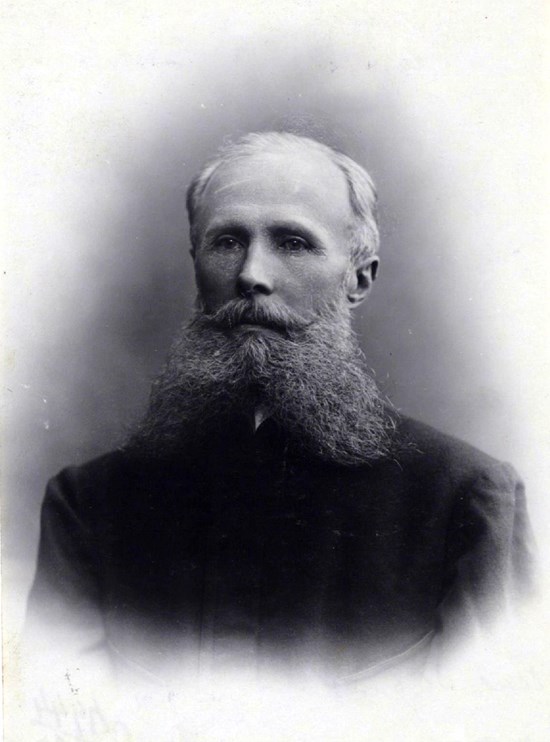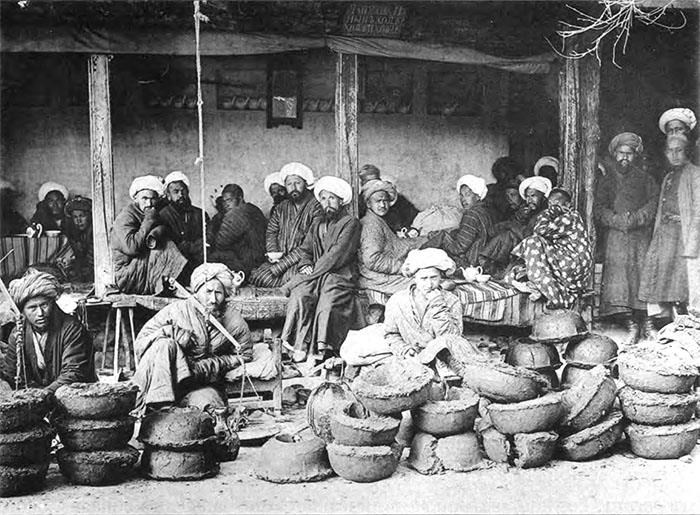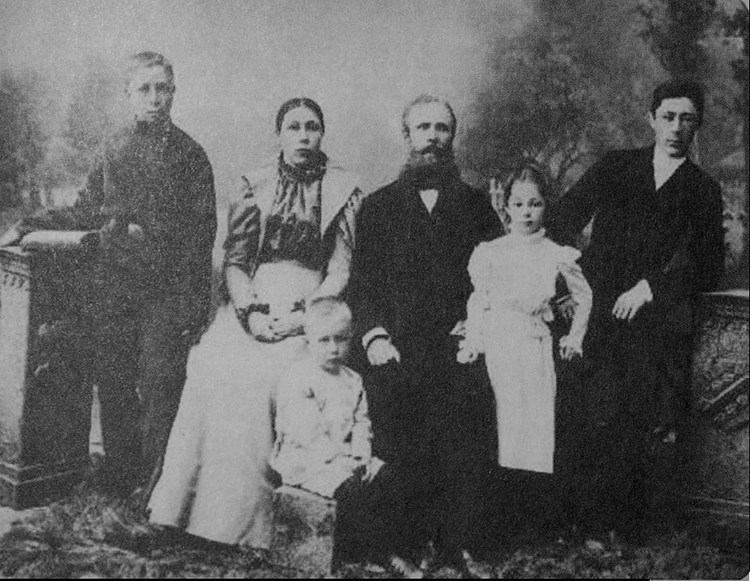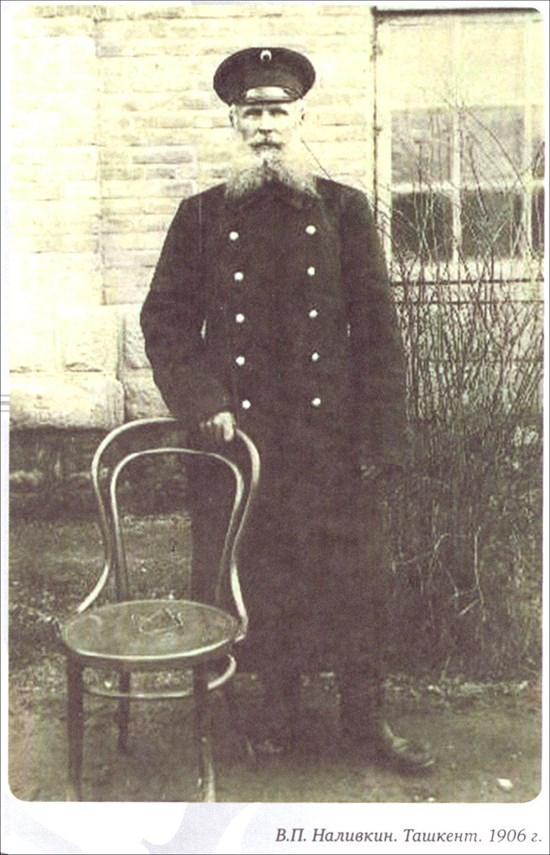Oriental novel
Once upon a time there was a boy. The boy’s surname was a little operetta - Nalivkin. But at the same time, all the Nalivkina men were warriors, so from the birth of the boy they were preparing for military service.

The name of the boy was Volodya.
After graduating from the famous Pavlovsky school, Volodya Nalivkin, as one of the best graduates, was distributed to the guard, to the Izmailovsky regiment, but refused a prestigious place and asked to Turkestan.
There was a war, there Russia was growing in new lands, as if descended from the pages of the tales of "A Thousand and One Nights."
The very next year, after arriving at a new duty station, a 21-year-old coronet takes part in a military campaign in Khiva. It is famously fighting, for which it is prematurely promoted to the rank of centurion. The conquest of Turkestan is in full swing, the “deeds” follow one after another, and after the Turkmen expedition, the distinguished centurion Nalivkina is encouraged by an unscheduled vacation.
He goes to relatives in Saratov, and there, on the banks of the Volga, Volodya Nalivkin realized that he was dead.
***
Once upon a time there was a girl. The girl’s surname was Italian - Sartori, but the girl was born and raised, as well as several generations of her ancestors, in Russia, so her name was simply Masha.

Masha was not a special beauty, but she was a great smart girl, and all the Saratov nobility, according to which Sartori was listed, considered her the first bride of the province. Masha Sartori received a brilliant education at that time - she graduated from the Educational Society of Noble Maidens, better known as the Smolny Institute, was fluent in French and German, and loved theater and music. Like most provincial brides, she dreamed of breaking out of the boring Saratov, shining in the capital and traveling to Europe.
But after meeting with Volodya Nalivkin, she realized that plans were changing radically.
Masha fell in love with the dashing Cossack centurion, the hero of the Turkestan wars. Fell in love to death - in every sense of the word. And in the sense - "strong", and in the sense - "for life."
The feeling was mutual: many, many years later, the daughter-in-law once jokingly asked Nalivkin what he would do if Maria Vladimirovna then refused to marry him in Saratov? Nalivkin, without thinking for a second, answered very seriously: " I loved her so much that in this case I would have committed suicide immediately ."
Just a few days after the wedding, the head of the newly made family came up with a challenge - the conquest of the Kokand Khanate began, in connection with which the centurion Nalivkin recalled from vacation. As it was written in the precept, "you should depart at the place of service without any delay and at all possible speed . " Military bone does not need to be explained what a similar order means, and the very next day the young spouse was on the way.
A twenty-year-old husband's wife, who did not even have time to realize her new status, had to get to her husband’s duty station on her own and alone. Naturally, there was no railway connection with the conquered Turkestan, and Masha for two months alone traveled from Saratov to Tashkent on horses and camels, through the steppes and deserts, through a turbulent country where military operations were still underway. Goes to Tashkent, not even knowing whether she will find her husband there alive.
The husband was alive, but upon arrival, Masha found out that their whole life had collapsed. In the Kokand campaign, Skobelev threw hundreds of Nalivkin to finish off a fleeing crowd of Uzbeks, where, as it turned out, there were women and children along with men. The centurion Nalivkin, in a fever of battle, slashed a figure running in front of him with a pull, he fell face up, and it turned out to be a 10-12-year-old teenager. As Nalivkin himself wrote, he remembered the eyes of this boy until his death, "I understood that it was difficult for me, almost impossible to be a member of such an orgy anymore."
Nalivkin submits a report on expulsion from the army. Masha, who arrived, finds herself alone with her unemployed husband without a livelihood for thousands of miles from relatives and relatives, in Turkestan, where fighting is still ongoing.
Volodya gets a job in the military-people's administration of Turkestan, which was engaged in the affairs of the local population, but quickly feels that he lacks knowledge. And most importantly, he can’t work due to extreme emotional shock and the ensuing deep depression. The army was everything to him, he knew nothing else and did not know, and his whole world collapsed. He found himself in the position of a fish that was pulled out of the water onto the shore - more precisely, which itself jumped there.
The only thing that made him live on was his young wife.
And it was Maria who offered her husband a very unexpected, even shocked, exit.
She sells all the jewelry she received from her parents as a dowry. Volodya resigned from service in management and finally retired "due to illness" with the rank of staff captain "with a uniform."
With the money received for earrings and rings, the Nalivkina spouses buy a small plot of land in the village of Nanai near the city of Namangan and begin to lead the life of ordinary farmers. In a country that is still being conquered, in fact, among a people about whom no one knew anything. In those years, not counting the military, three Russian families lived in the vast Namangan district, counting the Nalivkins.

And how they lived! They led the life of the Central Asian peasants.
As the first biographer Nalivkina Yakubovsky wrote, “ he put on a Sartov robe, she covered herself with chimbet and burqa and so they lived not one or two weeks, but six years, plunging headlong into the thick of life. Life was far from easy. In such a situation, in a damp cold sakla ... their older children grew up and were brought up who did not know Russian speech until seven or eight years old . ”
Six years. Six years!
Here you are, Masha, and life in the capitals, here you have trips to Europe. Bake bread, cook dinner, milk cows and camels, wash and sheathe her husband and children, make dung from manure to have fuel for the winter, to roam in the mountains with fellow villagers in the summer - otherwise the cattle will fall from starfishes.
The habit of hard physical labor remained with the spouses for life. As the grandson recalled, even in old age, Vladimir Nalivkin " got up at five in the morning and worked with ketmen on the site of one or the other son until eight o’clock, after which he had breakfast and again waved heavy ketmen until noon, and sometimes even up to two . "
But it should be understood - the Nalivkins were not just peasants. They purposefully studied the local population, anticipating the “included observation” method, which would become popular in world anthropology in only a few decades.
As a result, at the end of these six years, they had such knowledge that no one else had. Nalivkin, once again employed by the civil service, was considered the best expert in Russia on native Turkestan all his life. He enjoyed great authority among all Turkestans, both Russian and local, who always respectfully called him “domulla”, that is, “teacher”.

V.P. and M.V. Nalivkins with children Boris, Vladimir, Natalya and Alexandra. Early 1890s
The spouses perfectly mastered the Turkic and Persian languages, it was the Nalivkins who wrote the first Russian-Uzbek dictionaries, and later released their most famous book, "An Essay on the Life of a Woman of the Settled Native Ferghana Population."
That way the book was a shock to orientalists around the world. For the first time, world science has received reliable information about the most closed topic for researchers - the everyday life of a Muslim woman in the East. The most famous orientalist in the world, the Hungarian orientalist Arminius Wambury, enthusiastically wrote to the authors: "Your essay on the life of a woman in Kokand amazed me all the more because there is no such essay on Muslim women ... and without any flattery, the picture you painted should satisfy any ethnographer . " And many decades later, the Soviet academician V.V. Bartold admitted somewhat embarrassingly that "in studying the life of settled Uzbeks ... the work of the Nalivkins, who directly studied the lives of Uzbeks, living in the village and in no way different from them, still stands alone" .
This book was awarded the most honorable scientific award of Russia at that time - the Big Gold Medal of the Russian Geographical Society. She turned the world view of the notorious "slave and slaughtered woman of the East." Nalivkins convincingly showed that life is life everywhere, people are everywhere people. To make it clear, here’s just one paragraph for you, for example:
There are always more than enough reasons for quarrels and bickering, especially if the husband does not live at home, and the wife receives support from him in her arms. These quarrels, sometimes lasting several weeks, are accompanied by loud curses, promises to run away, go to a brothel, interrupt dishes, etc. For his part, the husband also warns of his intention to beat him half to death, expel some parts of the body from the house and spoil so much that entry into the brothel will become completely impossible. However, these promises, as usual, only remain promises: the cauldrons, the dishes, and the parts of the body remain intact; the wife does not run away, because she has nowhere to run away positively, with no one and nothing, and she is not driven out because her husband does not have money to pay her mahr.
And, of course, the receipt of this unique material about women's life is, first of all, the merit of Maria Vladimirovna Nalivkina.
It was she who became the first woman anthropologist in the world. A researcher who managed to become “her” among the Uzbeks, to collect, and then comprehend, unique ethnographic material. It is only in the West that the work of famous women anthropologists like Margaret Mead or Ruth Benedict is studied by students from all universities, and only specialists remember our Maria Nalivkina.
There was much more in her life with her husband - you can really write more than one novel about this “oriental romance”. Volodya served in the bureaucracy, because of his difficult nature he often cursed with his superiors, but his highest competence and enormous capacity for work ensured him a quick career advancement.

Members of the organizing committee of the XXV Turkestan agricultural exhibition. V.P. Nalivkin in the third row of the second on the right. Tashkent. 1909
He rose to the vice-governor of the Ferghana region, resigned in the rank corresponding to the general in the army. When retired, he suddenly became interested in politics, brilliantly won the elections to the second State Duma, becoming a deputy from the "non-native population of Turkestan."

In the Duma, he sided with the Social Democrats, which is why in Turkestan he gained a reputation for being “red” and a growing dislike of those in power. He met the February Revolution with enthusiasm, quickly took up leadership positions in the new governing bodies.
And since July 1917, Vladimir Petrovich Nalivkin became the chairman of the Turkestan Committee of the Provisional Government, that is, in fact, he was at the head of the vast territory on which five states are located today.
While her husband was making a career and fighting for justice, she was with her all her life. She brought up children, then grandchildren. She led a house, sorted notes, translated from Chagatai and Farsi, wrote articles and books. As biographers rightly noted, “along with the glorious name of V.P. Nalivkina must be put on the beautiful face of his wife, full of ideological self-sacrifice and readiness in the name of love for hard work . " Or, as their grandson testified, “a difficult life did not make her either a whiner or a hysterical woman, poisoning the existence of others. She never broke a demand for her husband to leave his chosen path and choose an easier and more relaxed one. Until the last days, she retained her courage and behaved with great restraint. ”
Unfortunately, like all good scientists, Nalivkin turned out to be a bad politician. Having quarreled both with the Provisional Government and with the Bolsheviks torn to power, he lost and was forced to hide, fleeing arrest ...

It was then, at the turn of the line for millions of 1917, that this oriental novel ended.
In November 1917, Maria Vladimirovna Nalivkina quietly died in their small house in the city of Tashkent and was buried in the Tashkent Orthodox cemetery. The husband, who was on the run, was not present at the funeral.
However, a few weeks later, hiding Vladimir Petrovich Nalivkin was found.
Found him at the Tashkent Orthodox cemetery.
He shot himself at his wife’s grave, leaving a note in his cap asking him not to blame anyone for his death.
In grief and joy, in wealth and poverty, in illness and in health, until death do us part ...
Disclaimer: To the inevitable question of “What does this have to do with IT?” No, I agree. But a rather popular hub “Biographies of geeks” exists on Habré, and it is deciphered as follows: “Life stories of wonderful people.”
I’ve been a sinful affair and thought - why not? Suddenly, IT and history are not “two things incompatible” at all?